Wow, it has been a while, has it not? 2021 was a light blogging year for me, mostly because recording/editing the Pretty Pixels Podcast takes up the time that I would have been normally dedicating to writing about games. I haven’t given up on it, though. I love writing about games and, with some luck, maybe I’ll do it professionally someday. For now, I’ll continue to post some general musings about the games I’ve been playing (if you’re interested in more regular thoughts, feel free to check out the podcast!). Given that my last post was in August, I have a lot to catch up on. Like, a lot. Let’s get into it. Grab a mug of your favorite hot beverage (I’m sipping hot chocolate out of a Meg Turney mug I bought myself for Xmas) and join me on this meander through the many games I’ve played through fall and into winter. [Spoiler warning: there will be some spoilers in both the text and images, so skip any games you don’t want spoiled]
Back 4 Blood
Back 4 Blood was one of my most anticipated games of the year, due in no small part to my love for the Left 4 Dead games. It was mostly just my friend Ron and me playing those games, but this time we had a full crew, as we were joined by my friends Tab and Paul. The best parts of my experience with this game mostly came from playing with friends, but there were some things I really liked in the game itself. I was very worried about the card system that the game introduces to the Left 4 Dead formula. I’m personally not a fan of card-based systems usually, so the idea that I’d have to worry about building and managing decks instead of just running around and gunning down zombies did not sound appealing. Almost immediately I realized that I didn’t need to use the cards at all, if I didn’t want to. They boost and modify your stats, but I could safely ignore them and still contribute to the team.

I did want those boosts, though, so I began adding cards here and there, looking for cards that fit my playstyle. Before I knew it, I had a regular run deck, a healing deck, an endgame deck, and a grinding deck. Clearly, I was more into the card system than I thought I would be. I was also into the character classes. Again, I could ignore them if I wanted to, and I didn’t give them much thought when choosing to play as Doc. She’s very cute and she’s a doctor. That was good enough for me! Once I started getting cards that significantly boosted my already increased healing abilities, though, I decided to become a great healer in order to help the team out. The running around and shooting zombies part was as fun as I’d hoped it would be, so the fact that I came around on the two things I was worried about – the card system and character classes – means that my time with this game was fun and filled with great moments with friends. The fun came with some frustration, however. The uneven difficulty was very annoying. We usually play games on “normal” difficulty, but we unanimously agreed to play this game on “recruit,” and even then, we found certain levels very, very hard. We have yet to beat the final stage, in fact. We only tried a few times but had no interest in beating our heads against the wall. The card/cosmetic progression is also very weird and annoying. Why can’t I just earn things for my character? Why do I have to unlock many, many cards and accessories for characters I never use, just to get one thing for my own character? And why can’t I earn experience in solo play? This is not a competitive game. The clothing variety is also severely lacking. They’ve fixed/addressed some of these issues in a recent patch, so maybe they’re no longer applicable, but aside from these complaints I had a great time with Back 4 Blood.

Jurassic World Evolution 2
Jurassic World Evolution 2 was also one of my most anticipated games of the year, and I was more and more excited about it as we got closer and closer to the release date. I really loved my time with the first game, so even if this game was more of the same, I knew I was going to play the hell out of it. And I did. I haven’t gotten the platinum trophy for it because it requires that I beat the challenge modes on the hardest difficulty and, yeah, no thanks. I tried one of them and got my shit rocked so I’m good for now. These games aren’t really about challenge for me. Well, that’s not totally true. I started the first game with the intent of just using sandbox mode to make a beautiful dinosaur sanctuary, but I ended up really enjoying the campaign and the challenge of building parks on islands with different terrain/environmental challenges. The same was true with this sequel. My parks are rarely very pretty, but I love the thrill of having a new map handed to me and pausing to quickly generate a number of different layout possibilities in my mind.

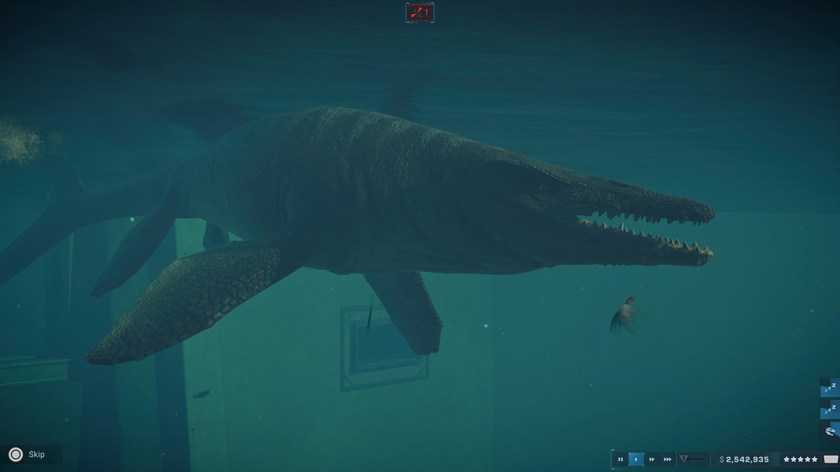

In the end, it still came down to the dinosaurs, though. Completing objectives is rewarding, but my main mission was always to keep my dinos happy and safe. Setting up a new paddock was always fun. I was so excited when I was finally able to unlock and afford to hatch a T-Rex. Like an expectant parent, as my new baby girl was synthesizing in the hatchery, I was constructing a large, roomy pen for her, altering the terrain to be mostly sand in the center with a nice half-moon grass border for the goats (and so she had something soft to sleep on), placing feeders both near water (convenience) and in a quiet spot near the back of the paddock (to get away from the guests when she needed some quiet time), planting a few patches of thick trees for scenery and hunting, digging a few water holes so she had some choices, and generally just making sure my baby gir- er, my T-Rex’s living space had everything she needed to be happy. It was experiences like this that I enjoyed most, as it was with the first game.


There were also some nice upgrades, big and small. I love the new terrain and weather options (though some of the storms can get fucked), the addition of avian and aquatic dinos is awesome, and the smoothing out of small things like path snapping was welcome. There were some seemingly small but fairly annoying bugs, though. Rangers can’t enter the water paddock or aviaries, so they send in drones. These drones would sometimes get stuck on things, causing all kinds of headaches. I had a Pteranodon that got injured in a fight. I sent a helicopter to tranq her so the medical team could treat her. The drone that was supposed to tranq her got caught on something in the dome, so the helicopter just kept circling the dome and the drone wouldn’t tranq the dino. I couldn’t reassign the helicopter, and when I took over manual control it would immediately return to circling as soon as I gave up control. My Pteranodon was slowly flatlining right in front of me and I couldn’t do anything about it. Well, I could, and I did, but no thanks to the glitchy drone. I built a new response station and viewing gallery, then sent the new helicopter team to do the job of the old one. What an expensive solution. Overall, however, I had a marvelous time yet again, hatching, raising, and caring for some beautiful dinosaurs.


Super Metroid
Oh, Super Metroid. You’d been on my backlog for over two decades. You were on the list of games I asked for leading up to my 13th birthday, those many years ago. Though I never did get you then, you were one of the first games I bought for the Virtual Console on my Wii. I was determined to knock you off the list – one fewer game for people to be like “wow, how have you not played that?” But I didn’t. I kept putting it off and putting it off. Then Metroid Dread was announced, and the new-2D-Metroid hype train left the station. I try very hard to avoid hype normally, but in this metaphor, I found myself standing in Grand Central Hype Station, watching the train leave with a wistful sadness. A new reminder that I had never played Super Metroid, oft celebrated as one of the greatest games of all time. As the release of Dread neared, I’d decided to give it a shot. Finally, a solid reason to also play Super Metroid, which Dread would surely be compared to by many.


And people were right. It is truly an excellent game. Returning to an older game can be hit or miss, but Super Metroid ages incredibly. Its controls feel tight and intuitive (a couple of special moves aside, which I’ll talk about later), the sprite graphics and animations are still beautiful (is this one of the earliest examples of “floaties,” multi-layered atmospheric graphics, being used in games?), the music and sound remains iconic, and the level and game design was so masterful. The way the game introduces a new power or mechanic and immediately requires you to use it (by, say, trapping you in the room you got it in and making the only exit blocked by an obstacle that requires your new power) is also great. The way many of these elements came together to create a unique atmosphere of disquiet, loneliness, and horror was probably my favorite thing about the game, though. It just felt cool. As mentioned, I did find myself a little frustrated by the lack of clear tutorial for some of the special moves, like the Shine Spark. A friend mentioned that there are little creatures that show you how to do them, and I was sure I must have missed them. I looked them up (the Dachora) and I feel very confident that I never saw one of them. Granted, I didn’t explore everywhere and was rushing through a lot of the areas, so maybe I just missed them altogether. Space and wall jumping also seemed slightly delayed. Like, instead of hitting the jump button as soon as Samus touched a wall to jump again, you had to wait a split second for one frame of her foot to change, so it was more difficult than most other wall jumping mechanics I’ve tried. These are very minor complaints about a game that is approaching its 30th anniversary, so don’t take them too seriously. I loved my time with Super Metroid and was fully stoked for…
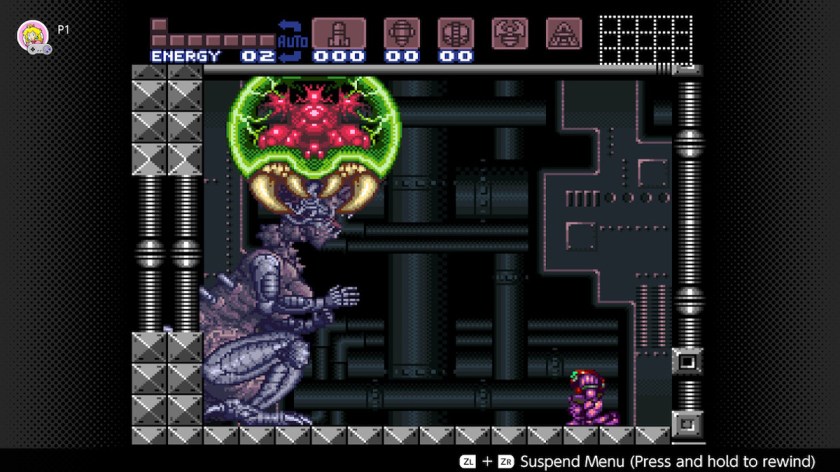

Metroid Dread
Having just played Super Metroid, I was immediately struck by how familiar Dread felt. There were two Metroid games released on the NES before Super Metroid came out on the SNES, but you’d be forgiven for not knowing that given how often every subsequent Metroid game was compared to its SNES forebearer. It’s clear that Nintendo wants to be faithful to that template, and I don’t blame them. Despite the Prime trilogy’s success in moving the series to a 3D perspective, Super Metroid’s legendary status seems to be something fans want to revisit in the 2D titles. Having finally played it, I can understand why. Dread captures much of what I loved about Super Metroid, irons out the couple of wrinkles, and delivers a more easily digestible (and arguably more fleshed out) story via cutscenes and voice acting. I loved Samus in Super Metroid, but she has so much more attitude and personality in Dread. Her poses are so deliberate, her head movement and gestures are subtle but full of emotion, and the final scene was so incredibly badass and cathartic.


Cathartic might seem like an odd word choice, especially given my limited experience with the series, but let me explain. With how long the Metroid series has been around, I’ve had many plot points from previous games spoiled. I knew that a lone baby Metroid becomes attached to Samus and views her as a motherly figure, and given that the baby isn’t present in later games I had a feeling that it probably died. None of that seemed to prepare me to actually play through that scenario. I was so excited when I ran into the baby Metroid near the end of Super Metroid. Maybe because it was a “baby,” and seemed to want to follow me, I was instantly enamored with it. I love (most) baby animals and creatures, so the idea of having a “pet” or “baby” Metroid was very appealing. I’d known this little parasite for but a moment and I was in love. Yes. Give me all of the baby Metroids. So, when it swooped in during my seemingly impossible and highly frustrating boss fight against Mother Brain, saving my life, I got misty-eyed. My little, strong baby, stepping in to save me and bestow me with great powers. My heart. And then that bitch-ass, shit-eating Mother Brain killed it. She killed my baby. I was furious. Should I have been? Well, that’s subjective, I guess. This was my first Metroid game, so these characters were new to me, and (as I said) I had barely just met the baby Metroid – but the feelings came, regardless. I was so sad to lose my new baby friend, and so angry that Mother Brain had done so callously and with great malice. I relished the opportunity to use my newfound Metroid powers to murder Mother Brain in kind.



Samus’ Metroid DNA is a huge part of the Metroid Dread story, and although I haven’t played any of the games between Super Metroid and Dread, I can’t help but imagine that some of that DNA must come from my poor, sweet baby Metroid’s gift of power near the end of Super Metroid. Regardless of whether it’s canon, in my head I was carrying the death of my Metroid baby with me, infused in my DNA. So, when Samus scream in fury and transforms into a beastly Metroid-infused hybrid and blasts away the final boss… I felt like my baby Metroid was with me, helping me once again. I should also mention the EMMIs, which I really liked. They weren’t as pervasive as I’d expected, but that was a good thing. I wasn’t looking forward to being stressed out constantly, so only having to quickly navigate the EMMI zones was fine. Also, I think the EMMIs highlight the great level design. Every EMMI is the same in terms of powers and abilities, so the methods you employ to take them down don’t change with each new EMMI. What does change is the level design, and thus your strategy to employ those methods. It takes some time to blast away the EMMI’s face shield, then charge a shot, aim, and hit their weak spot. In order to have that time, you need to evade the EMMI and find a spot that will give you the time you need. With the first EMMI, they give you a nice, long, straight platform. By the later EMMIs, the zones are designed so that you have to evade a lot and keep an eye out for an area that might work. You might find one, set up and start blasting as soon as the EMMI rounds the edge of a platform, only to find that you’re just shy and have to perform a counter to evade again and find a new spot. It was very thrilling. Speaking of the counters, the sensation of landing one of those successfully is amazing. It’s one of those video game chef’s kiss moments that just feel so good. Overall, as with Super Metroid, I loved my time with Dread.


Metroid: Samus Returns
I loved my time with Dread so much, in fact, that in the middle of playing it I went and looked to find other Metroid games to buy. I am, I guess you might say, a Metroid convert. Well, not really a convert, since I never hated it. Maybe a newly minted Metroid devotee? A baby Metroid fan, if you will. See what I did there? Because I’m a fan of the baby Metroid… and I’m also… never mind. Anyway, I already have the original Metroid and Metroid Fusion (thanks, 3DS Ambassador Program!), so I ended up getting Metroid: Samus Returns, since it is a remake of the second game in the series and one of the more recent entries. I was a little concerned about playing an intense platformer with potentially tough boss fights on my 3DS, with the shoulder buttons being in a position that makes my hands feel weird, but I barely noticed that. What I did notice was the similarities to Dread, which make sense given that they were made by the same developer just four years apart.

Much of what I loved about Super Metroid and Dread was present here, too. The beautiful backgrounds and environments, the haunting, eerie music, the responsive controls and carefully considered level design, and the generally immersive, addictive atmosphere. After three Metroid games, I feel like I can say that one of my favorite things about the series is the boss fights. The enemy design and combat are great, sure, but I think the developers have done a great job with difficulty balancing. In all three games, I found myself in similar boss fight situations: enter a room, get absolutely demolished by the boss, wonder if I’ve ever played a video game before as I softly weep to myself, try again and get crushed again, consider the possibility that this boss is impossible and these developers should die, try again and start to get the first couple of wave patterns, die a few more times as I get better and better, then beat the boss and feel like a superhero and the best gamer in the history of the world. I loved that most bosses seemed so hard at first because it made the victory so rewarding. I kind of rushed through Super Metroid, so I think I got something like 45% of the collectables but didn’t feel particularly compelled to get the rest. I got 50% of them in Dread but was also pretty satisfied with that number. Somewhere in the middle of Samus Returns, I realized I wanted to extend my time with the game and get all of the collectables, so I 100%ed this one. I’m so glad I’m finally Team Metroid. I love these games.
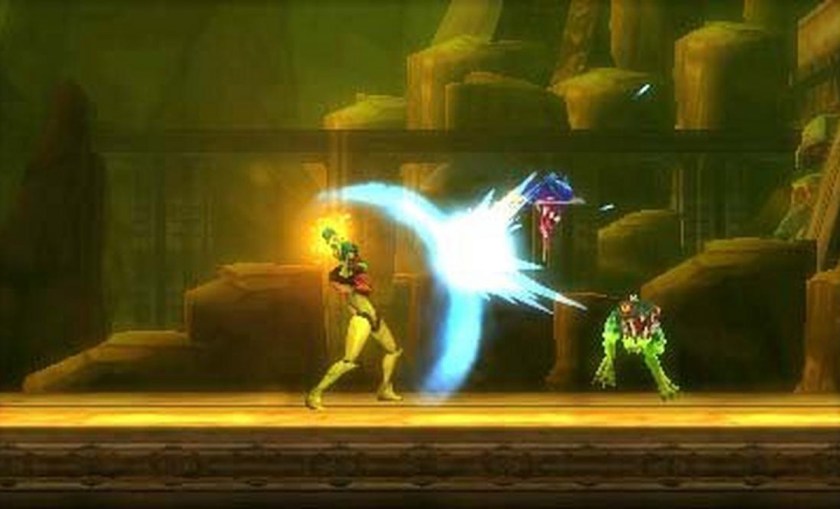

Halo 4
As with Metroid Dread, I felt a need to play older Halo games that I’d missed prior to jumping into Halo Infinite. I’d played the first three Halo games and liked or loved them all, to some extent. Halo 3 was my favorite, and I played a ton of it, so playing Halo 4 seemed like a given when it first launched. I can’t recall why, but I passed on it when it came out. It might have been in the two-year window where I had mostly stopped gaming because I was busy with school, or the concern about the studio switch from Bungie to 343, or any number of other factors, I guess. I did end up buying it at some point, but it’s sat on my backlog along with Halo 5 Guardians, which I also purchased at some point (but wouldn’t play until I’d played 4, for obvious reasons). One of the most interesting things (to me) about playing Halo 4 was the controls. I’d played a fair amount of the Halo Infinite multiplayer before diving into 4, and those controls seemed so intuitively Halo to me that when I played 4, with its slightly outdated and uncustomizable controls, I kept making mistakes and crouching when I meant to melee and reloading when I meant to throw a grenade. It wasn’t a deal breaker, but it just felt weird.

I played the Master Chief Collection version of the game, so it looked amazing. I was frequently impressed with the graphics, the sound design was as solid as always, and some nostalgic gaming itch was scratched when I woke up on a spaceship in distress, having to procure weapons and fight my way out. The reason I’m most happy that I played it before Infinite, though, is that this entry seems critical in terms of Cortana’s storyline. I’ll talk about why I was so glad when I talk about Infinite, but I enjoyed the plot wrinkle of Cortana having to deal with the concept of death.

Halo 5: Guardians
Halo 5 seems to be a controversial entry in the series, as I’ve heard that so many fans were deeply disappointed in the campaign. In terms of gameplay and fun, I thought it was great. The presentation (graphics, production, actors, etc.) was above and beyond the previous entries. It seemed clear that this was meant to be a much “bigger,” even more mainstream addition to the overall story of Halo. The controls were modernized, and the addition of the ability to mount ledges was very cool. I had a ton of fun with the game overall, though I can see why hardcore Halo fans were probably disappointed in it. The story of Halo had always followed Master Chief and Cortana, so when the narrative is shifted so dramatically to where they’re more like side characters in a grander story, it was probably jarring and unwelcome. Pair that with Cortana’s switch to galactic villain, after the previous game further made her into a close, intimate partner for Chief, and I can see why fans were upset. Still, I did have a hell of a time playing it, and I think the knowledge that I was immediately going to play Infinite after and get a resolution to the Chief/Cortana story made it not feel quite so severe.

Halo Infinite
My time with Halo Infinite involves the online mode and the campaign, so let me start with the online multiplayer, which was available first. Halo 3 was one of the few games that I really, really got into online, and I played a whole lot of it. I was just shy of the rank of Staff Captain and had almost 500 ranked matched under my belt. My time with the Infinite multiplayer is giving me the same kind of magical feels that Halo 3 did. Part of it might be that I have/had a dedicated group of friends to play with, but I also feel like the matches are just fun. It took a while to get back into the rhythm of playing Halo online, though. When we first started playing, I did what I do in most shooters: try to shoot people to death. The problem in a Halo game is that it’s designed to force you to think creatively because of the shields. If you’re very accurate and you get the jump on someone, you can take them down with just your rifle or pistol. That rarely happens, though, so you must get into the habit of using your weapon to down their shield and then either switching to a secondary weapon, getting close enough for melee, or hitting them with a grenade to finish them off. When you get in the rhythm, it feels so good. I played a match the other day where I went 17-3 (rare for me) and everything was just clicking. I had at least three kills where I use a clip of my assault rifle to down their shield, then switched to my pistol and finished them off. I felt like such a badass, heh. It can also (often) not go right, and it’s frustrating to feel like you’re always a second shy of winning every faceoff you get into. Either way, I’ve been having a blast online. I do wish the battle pass rewards were better and more frequent. They break every aspect of appearance into numerous items, so it takes forever to unlock a small component of an armor set that you might not even use. Still, I see a great many more matches in my future.

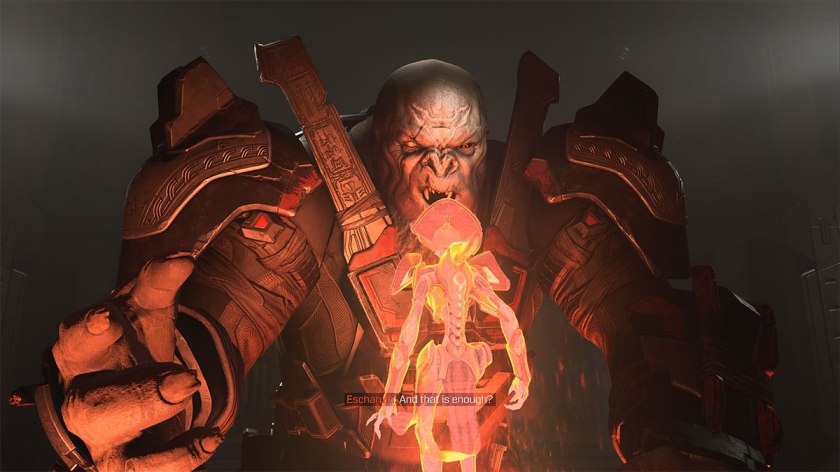
As for the campaign, I really loved it. The open world was a little sparser than I’m used to from modern open world games, and many of the activities just involved killing enemies or grabbing something, but that was fine. I still enjoyed zipping around with the Grapple Shot, clearing out FOBs, and finding Spartan Cores or multiplayer cosmetics. The story is what I really appreciated, though. This entry returns to the classic Chief-centered adventure involving Cortana. I really liked his new AI companion, Weapon, and this is where my previous note about being glad I played 4 and 5 comes in. I’ll throw an extra [SPOILER] tag up, since this game is still so new. The Weapon’s reaction to finding out she was a copy of Cortana hit me so hard. She was genuinely hurt when Chief tried to delete her as a safety measure, since he had failed to do so to Cortana, and in this moment, she was confronted with the reason why, and her emotional response was powerful. Add to it Cortana’s final goodbye, near the very end of the game, and I was a misty-eyed mess. These moments wouldn’t have been nearly as impactful if I hadn’t played Halo 4 and 5 just before, so I am very happy that I did. The ending wasn’t nearly as final as I was expecting, which is good. I am ready for more Chief and Weapon adventures.


Life is Strange: True Colors
I loved Life is Strange and Before the Storm, and really liked Life is Strange 2, so I was very excited for this game, especially because they finally ditched the episodic release schedule of the previous entries. I think the nostalgia and charm of the first game and its characters keeps it my favorite in the series, but True Colors comes close to unseating it. While the story wasn’t quite as epic and dramatic as the other games, it felt more focused and grounded. It felt shorter but tighter, narratively. I love the smalltown Colorado setting, and the characters were great.
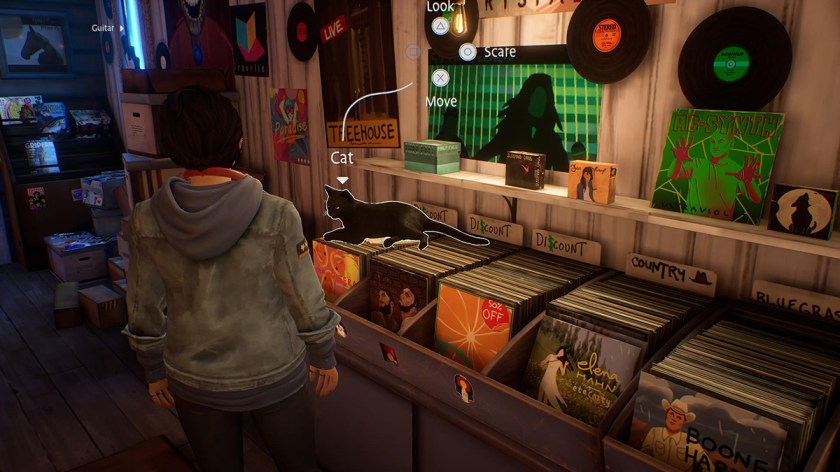
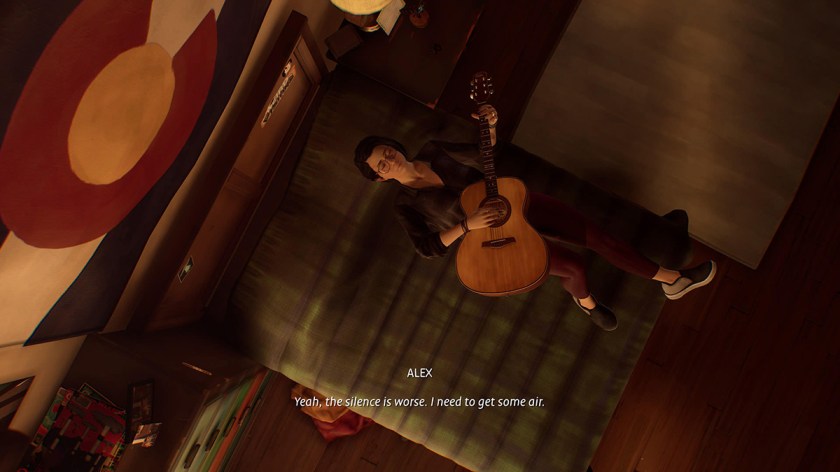

One of the things I appreciated most about this entry was the range of emotions you encounter throughout the game. In the previous games, it felt like a one-way street in terms of plot development and tone: they started cheery and “normal,” then became darker and darker as the story progressed and more supernatural elements were introduced. It was all justified by the narratives, but it was kind of a bummer. By the end of Life is Strange 2 I was just sad. True Colors does so much more with emotion and jumps around a lot, which made it feel more dynamic and satisfying. I loved the soundtrack, the chapter where you play out an epic, town-wide LARP game, and overall I thought the story, choices, and ending(s) were great.



Before Your Eyes
I’m going to go light on the spoilers with this one, because it’s a short and narrative-heavy game, but it’s going to be difficult to talk about my reaction without giving anything away. Before Your Eyes is a short and relatively inexpensive game ($9.99 regularly on Steam, currently on sale for $5.99), so if you have any interest in playing it, I’d recommend to just avoid my (and other people’s) thoughts and just play it. This is the kind of story that’s most impactful without a heads up about what’s coming. Having said that, let me first talk about the “gimmick” of controlling the game by blinking your eyes. If you haven’t heard of this game, it’s a narrative indie game that uses your webcam to detect blinks, advancing the story every time you blink. I thought that this meant that if you didn’t blink, a scene may play on for many minutes, but that’s not the case. Scenes are mostly contained and very deliberate in what they are showing you. If you just stare, refusing to blink, the dialogue will end and you’ll find yourself just watching someone looking out to sea, or someone doing the dishes, for a long time. So that made it feel less gimmicky to me, because it wasn’t about the novelty, it was still about the story. It worked really well, in terms of implementation, too. There was maybe one or two times where the scene advanced and I didn’t feel like I blinked, but it accurately registered my eye motion a vast majority of the time.
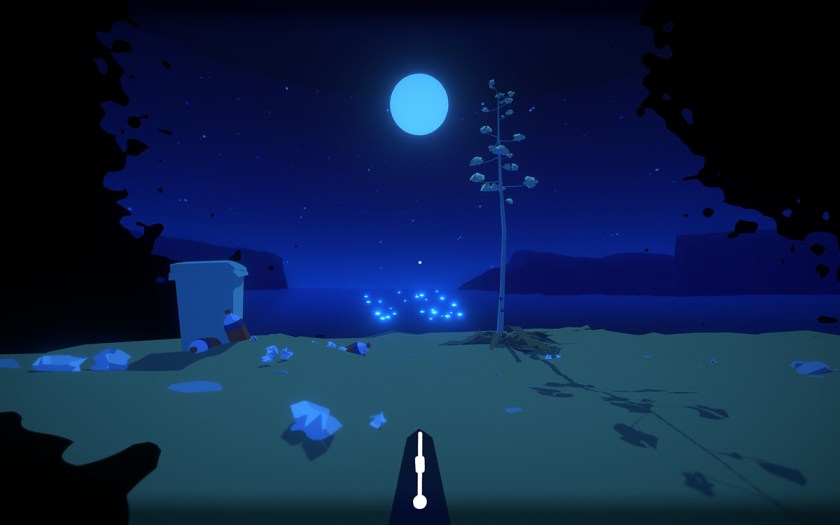

Beyond the blinking mechanic, which I think is such a cool, novel way of involving the player in a story about memory, the story just crushed me. As I said, I won’t get into specific spoilers, but broadly speaking the narrative takes a turn at a certain point and I found it very difficult to avoid blinking with all the tears spilling from my eyes. This sadness was different than the sadness that I felt at the end of, say, Life is Strange 2, where after hours of trauma and horror, I just felt drained. Before Your Eyes is such a short experience that I walked away weirdly thrilled by how much it moved me. I’m no stranger to crying during video games, but it’s rare that I’m struck by the kind of emotion that overcame me with the ending to this game. I don’t watch many streamers nowadays, but this is the kind of game that I’d love to see people play, so maybe I’ll have to look up some reaction videos.
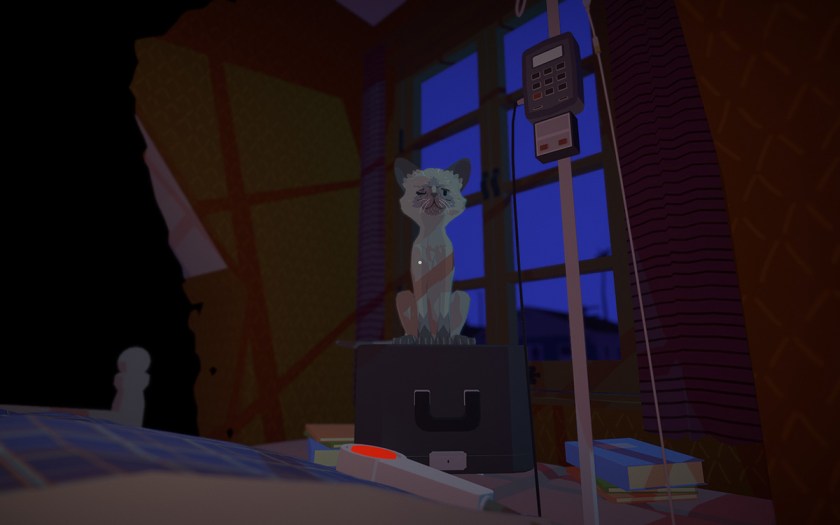
C14 Dating
I’d picked this game up on a whim during a sale, and it took me a bit to get into, but I was mostly pleasantly surprised by it. It’s a dating sim that puts you in the role of Melissa, a young student who attends a summer research trip to Belgium. I was all in for the dating sim part, but when the game introduced a social management system and an archeological dig puzzle, I was worried that they would distract from the dating.


Not so (besides, you can turn the puzzles off if you want to). The digging puzzles turned out to be pretty fun, and the social management stuff was inobtrusive and also kind of fun in its own way. I don’t know why, but I really like journals in games, so that helped. Some dating sims can really drag on with too much dialog, but I found the pace of this game to be solid, and as a former wannabe geologist, I appreciated the many geology/archaeology puns throughout. Even the title is a pun (C14 dating is carbon dating)!


The Dark Pictures Anthology: House of Ashes
As a big Until Dawn fan, I’ve been chasing that high with every new Supermassive release. I was very disappointed in Man of Medan, I liked Little Hope enough to get the platinum trophy for it, and House of Ashes was… somewhere in between. I’m a fan of the photorealistic graphics of these games, and this game doesn’t disappoint in that arena. The characters and environments look great. The setting was hit or miss for me, though. Isolated cabin in the woods? Yes. Ghost ship. I can dig it. Abandoned witch town? Aw yeah. Caves and ancient ruins? I guess? It’s not bad, but it was my least favorite of the series’ settings, especially given the military angle as well. As a veteran, it was hard not to be distracted by some of the silly mistakes, given that most of the presentation seemed to strive for realism (supernatural/alien elements aside, of course). Eric is way too young to be a Lt. Col. It’s highly doubtful the other soldiers/Marines would speak to such a high-ranking officer in the way that they did right off the bat, too. There was one of those terribly incorrect military salutes at one point. Again, I know it’s silly to get caught up on stuff like that, but it was distracting.


I didn’t hate the game, though. I didn’t even dislike it. I just had some minor problems. I found the moral choices to be fairly solid (though they still do that annoying thing where they seem to deliberately imply that you should make a choice that ends up being the wrong one), the story was pretty interesting, and I thought the twist was pretty cool. There was one thing I did want to touch on, though, because I haven’t seen anyone mention it. There is what certainly seems like digital brown face in the game. The character of General Dar is an Iraqi general, voiced by a Canadian actor of Egyptian descent who speaks fluent Arabic. The character model, however, is of a white actor – the same one used for the character of John in Little Hope. I get needing to reuse assets to get these games out as frequently as they do, but there’s something about using a white actor and just changing the color of their skin to make them another nationality that feels wrong. That and my previous quibbles aside, I mostly had fun with House of Ashes and look forward to the next Dark Pictures installment.

Nekopara Vol. 1 and 2
Like C14 Dating, I nabbed these games for very cheap during a PlayStation Store sale. I seem to buy a lot of visual novels when they’re super cheap and then never play them. Well, I had family staying with me recently and I was looking for PS4 games that I could passively play in my room while they slept in the living room, where my primary consoles are. The Nekopara games seemed like good candidates. I like the anime art style, and because they’re straight up visual novels I could just put them on auto and journal or do other things while I watched them in bed. The story was more interesting than I’d expected, and I really liked the “E-mote” animation system. It made the art so much more dynamic. I knew that the games were sexual in nature, but when I got to the first scene with nudity, I was surprised by how heavily edited it was. I also have the games for Steam (got them in a visual novel bundle in a previous Steam sale), so I decided to see just how heavily censored the PlayStation version was.

And, let me tell you, they are heavily censored, especially if the 18+ patch is installed on Steam. In the PlayStation version, when you become intimate with a cat girl, you… kiss. That’s it. There is at least one nude scene, but it’s heavily censored. In the 18+ version, there is graphic, animated sex. I was shocked. Not in the bad way, mostly. I like sexy games, when they’re good. But I will say that the question of age in these relationships is kind of weird. These are “cat girls,” so they age differently than humans, but it seems heavily implied that these girls are maybe too young to be having sex with their owner. The fact that he is their “owner,” too, and calls them his “daughters” struck me as a little icky. I’m guessing it’s part of the appeal of these kinds of stories for some people, but it felt a little off to me. Still, I like the art and story, and I’m all for pervy sex games, so I’ll probably finish the series.

Lake
I was very excited for Lake after seeing it in one of the indie showcases at E3 earlier in 2021. It looked like a perfect fall game. Cozy, quaint, and charming. I think the phrase I used to describe it when it came out was “good, but rough around the edges.” There were some pretty significant bugs at launch, including one that prevented me from continuing the game until it was patched. Some of the character movement and action prompts seemed loose or glitchy as well. The story, of a woman who takes a break from her high stress IT job to deliver mail for her dad in their hometown, was good. I really enjoyed getting to know the characters of this small town, though I was left wanting more. There seemed to be some stories or things in the world that may have been meant for something and were never mentioned again. You meet a character who says she’s the town mechanic and will fix your mail truck whenever you need, for example. This is pretty standard telegraphing in video games/storytelling. Now you know who to go to when you need to repair your truck later. But that time never comes, so why include that line? It doesn’t seem like much of a stretch to think that vehicle repair was supposed to be included at some point but was dropped.


So, the story and writing were good (if a bit unpolished), but the thing I really wanted more of was delivering the mail. You start each day with a number of letters or packages, then you just drive around and drop them off. It’s so simple yet so satisfying. It’s the core of the gameplay, so I imagine the relaxing, rewarding nature is meant to play into the big decision you make at the end of the game – to stay in this small town and keep delivering mail, or go back to your big city IT job. Which is great and all, but when you make a mechanic that’s so satisfying, why not give players the option to do more of it? I really wanted an endless mail delivery mode. I chose to stay in the small town, so I was somewhat disappointed when the game didn’t allow me to keep delivering mail after the end credits. Maybe they’ll patch it in later, or make a sequel that’s just called Mail, where that’s all you do is deliver mail. That would be nice.


Deathloop
I wasn’t all that excited for Deathloop until it was close to release, but the prospect of a pop-in-pop-out stealth espionage game got the best of me and I got it day one. None of my friends played beyond the opening of the game, though, and I was too nervous to open the multiplayer to strangers, so I ended up never having the (reportedly) thrilling experience of chasing or being chased by a friend as you/they tried to complete campaign levels. I still really enjoyed the campaign, though. It felt to me like the ultimate evolution of old school FPSs. After Halo, Medal of Honor, and Call of Duty, shooters took a very cinematic, guided turn, which I’m certainly not complaining about. But if you’d asked me in 2001, after playing games like GoldenEye 007, Perfect Dark, TimeSplitters, etc., to predict what an FPS produced in 2021 would look like, it would be Deathloop. There are so many facets that remind me of old school console shooters, like sneaking around unique areas, listening in on guard chatter, trying different approaches and weapons with the same levels again and again, quirky bosses who have specific routines, and more. The level design, which allows for numerous paths through and approaches to every level, was a great addition to the classic mix, and the overall presentation was stellar. I was happy that Maggie Robertson won the award for best performance at the (dumb) Game Awards for her performance as Lady Dimitrescu, but Jason Kelley and Ozioma Akagha’s performances as Cole and Julianna, respectively, were amazing. I loved their personalities and wanted even more interactions between them. The story was interesting, though it felt a bit disjointed, and the end was fairly disappointing, but after the first handful of hours or so I really got into the gameplay and, overall, had a lot of fun.

Far Cry 6
I was late to the Far Cry fandom, but I really liked my time with Far Cry 4, 5, and New Dawn. I know people complain about Ubisoft open worlds and the plethora of activities and collectables contained within, but I am such a fan of how well designed and crafted these worlds are. In terms of environmental variance, realism (geological features and topography), and tiny details, Ubisoft worlds are top-tier, so I always love exploring and experiencing the massive, beautiful landscapes. The island setting in 6 was beautiful and enchanting, and the cast of characters in this installment is probably my favorite of the games I’ve played. El Tigre! Everyone in the game was so mean to my Dani that I was initially suspicious of El Tigre’s motivations. He quickly became my favorite person to see at base camps, though, because he always greeted me warmly and really believed in me.
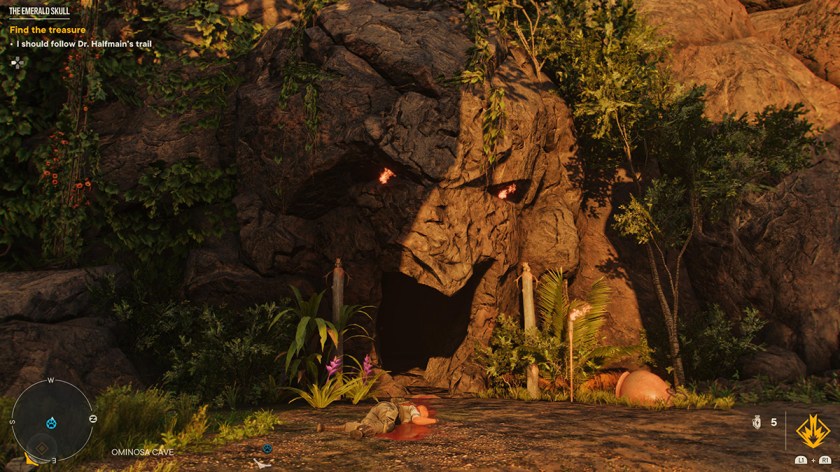


I also really liked Jonron. Mostly because of her abs. I’m kidding! She was very fun and friendly, and she was very athletic and cute. I also really liked the amigos. They were all great in their own way, but I stuck with the adorable, clumsy lil croc Guapo for most of the game – until, that is, I got Oluso. I have a black cat whom I love with all my heart, so when I found Oluso, a magical black panther who sneaks around and poofs enemies into the nether when she pounces on them, I was in love. She never left my side, and I wished that I’d had her with me from the start. Add the series’ typical solid gunplay, an interesting and well-acted story, and lots of fun activities and collectables, and I had a great time with the latest entry in the long-standing Far Cry series.


Sakura Succubus 3
Much of what I wrote about the first two entries carries over here, so I won’t retread too much. Like Nekopara, I played this on PlayStation first, then tried it on Steam. It’s more explicit on Steam, but not to the extent of Nekopara. The story is contrived and silly, but I dig it. The writing is mediocre, but I really like the art, though Nekopara has maybe spoiled me because now I want all of my static 2D characters to be animated in some way. Still, I can’t deny that I’ve enjoyed the Sakura Succubus games to this point.
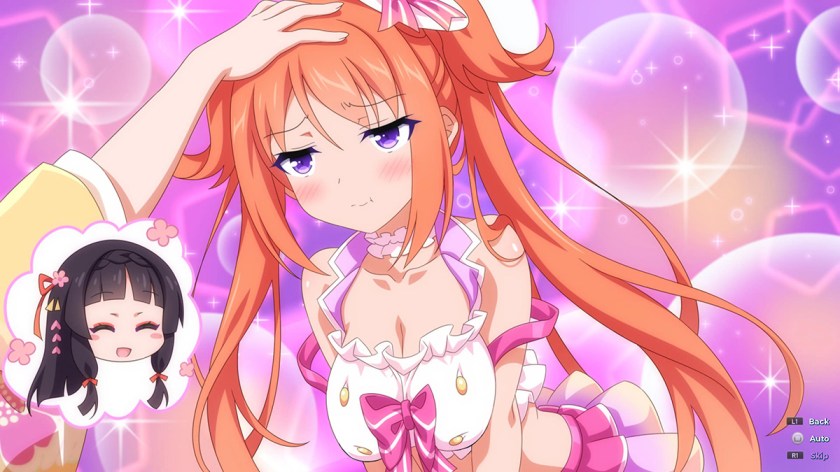


Pantsu Hunter: Back to the 90s
This game looked so weird and, frankly, bad, that I had to snatch it up when I saw it on deep discount during a PSN sale. It’s a point-and-click adventure game where you do various things to try and collect panties from several women’s apartments. It is… very weird and bad. But in a good way! The writing is so bad and poorly translated and the main character is terribly problematic, but the (also bad) limited voice acting, dumb scenarios, and retro art style was strangely charming. Kind of a so-bad-it’s-good thing.

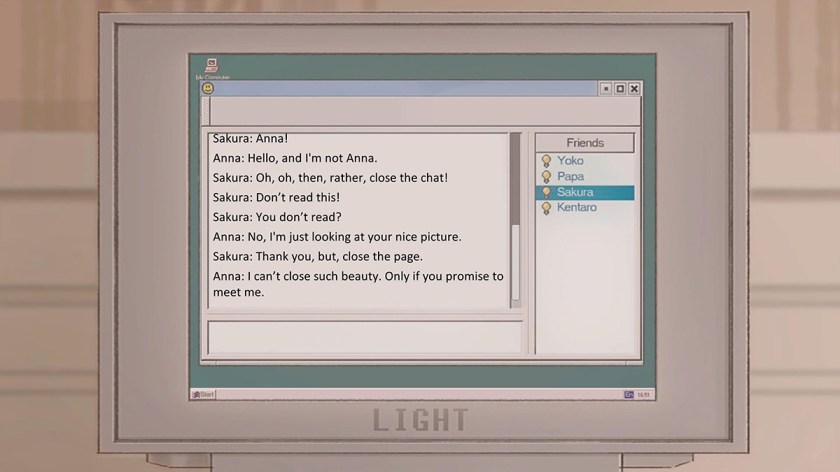

For example: in one scenario, if you decide to sit down in a chair in the kitchen, you die. You just die. Later, in a different scenario, you find a story that describes a local legend in which a woman’s husband is unfaithful and she orders a chair from a place that reportedly makes furniture for women who’ve been scorned by men. This mysterious company takes a while to get your furniture to you, but when it arrives it’s covered in a thin layer of poison that is undetectable and only harmful to men. The woman in the story (who is obviously the woman whose apartment you visited earlier in the game) breaks up with her boyfriend long before getting her freshly poisoned chair, so by the time she gets it she forgets all about the poison. That, apparently, is when you show up and decide to sit on it, dying instantly with much confusion. So, thanks to silly stories like that and a b-movie level of camp, I actually found myself liking this game. I wouldn’t say it’s good, exactly, but I had fun with it.


Dead by Daylight
As a huge horror fan, I’d been hoping to play Dead by Daylight for a long time. As soon as they started partnering with classic horror franchises like A Nightmare on Elm Street, Halloween, Silent Hill, and more, I was in. It’s an online multiplayer game, though, and I didn’t know anyone who played it. Enter Halloween 2021 and some friends who were looking for spooky games to play. We only played a handful of times, and it’s not a perfect game, but I thought our time with it was pretty fun. I especially liked being the killer, of course. Creeping around menacingly as Freddy Krueger, chasing my terrified friends into corners and slashing them to bits… that makes me sound a little disturbed, but if you’ve played it, you probably know that thrill. As a survivor, I found myself genuinely yelping a few times when a friend rounded the corner as the killer or found me hiding behind a bush. I wasn’t into it enough to continue playing online with strangers, but I had fun with my time hiding and slicing.


Radiohead: Kid A Mnesiac Exhibition
I am a big (if lapsed) Radiohead fan. Their early albums were a huge part of my teen years and are inextricably included in the soundtrack to my life. I haven’t kept up with them recently, but I still love their classic albums, especially OK Computer, Kid A, and Amnesiac, the latter two serving as the inspiration for this virtual art exhibit. There is no “game” to play, but exploring the many different rooms and exhibitions was very cool. The way they play with graphics, perspective, and sound is not easy to describe, and given that it’s free I’d just recommend anyone vaguely interested to just check it out for yourself. I’ll share just two key moments from my time, though, to give you a sense of what to expect. The entire museum or “exhibition” is made up of existing art and music assets from the Kid A and Amnesiac albums (thus the name), and many rooms are dedicated to one or more tracks from those albums.


“The National Anthem” is one of my favorite Radiohead songs, so of course I rushed into that room when I saw it. There were a few Radiohead bear characters standing around, looking at walls of televisions showing album art or other weird things. I could hear “The National Anthem” playing, but it was low and incomplete. There was a translucent, triangular column in the center of the room, which looked to be filled with some kind of amniotic fluid. As I stepped into it, the bass from the track kicked in and the song felt so much fuller and more alive. When I stepped out, it stopped.


There was also a room where a very large painting seemed to float in space in the distance. I walked toward it and, as I did, I realized that the painting was made up of thousands of what I might call 3D rendered pixels. The “pixels” that made up the flat-looking 2D image were actually long shafts of color that I then walked through. There is also a part where you enter and walk through the iconic cover art for Kid A, which was trippy. There were a number of other moments that would be difficult to describe, so if you’re interested in art, Radiohead, or just cool interactive experiences, I’d say just give it a look. It’s free, after all.


Mario Party Superstars
Some of my fondest multiplayer memories are of me and my friends Ron, Gari, and Tina playing the first three Mario Party games. We rented them often, playing for hours and even briefly adopting nicknames based on our character of choice. Mine was, of course, Peach, which is a part of where my love for that character stems from. What we loved about these games is that skill only counted to an extent. Ron and I were the big gamers in the group, so we had an unfair advantage in some of the multiplayer games we’d play. The Mario Party games even the playing field to an extent, because some of the minigames are less skill based than others (and some are outright based on chance), plus the games randomly give out stars at the end based on bizarre things that are usually out of your control, like how many Bowser spaces you land on. So, while Ron and I would dominate in some of the minigames, many of them were totally up in the air, especially when the game would pair us off in a 2 vs 2 or 3 vs 1 game. We had so much fun.


I’ve liked or loved most of the Mario Party games since, but I will say I was very disappointed with Mario Party 9 and 10, and also pretty unimpressed with 8. Super Mario Party for the Switch is pretty decent, but with no online play I’ve had little opportunity to play it. I played it by myself for a bit, but it’s never the same. Luckily, I’ve had lots of opportunities to play Mario Party Superstars with friends online, and this collection of boards and minigames from the first three entries (I think some of the minigames are taken from later entries, too) has fully restored my love for Mario Party. The game looks great, too, which is something I haven’t thought about the series in a while. I do wish there were even more boards, but hopefully they’ll fix that with DLC. Either way, I’ve had such a blast playing this game with friends. Peach is the Party Star, babyyyyy.

The Matrix Awakens
This “game” is a demo for Unreal Engine 5, and it begins with an intro that features the voice and likeness (both real and digital) of Keanu Reeves (as himself and Neo) and Carrie Ann Moss, then puts you in the shoes of a new character that helps Trinity evade pursuing agents by shooting them, vehicle tires, and a helicopter as Trinity speeds along a crowded highway. Eventually you’re free to explore this seemingly fictional city, walking, driving, or flying a drone around to look at the bustling metropolis. Many people have commented on the ability to look at various layers of the city, like surface mapping, lighting, the ability to increase/decrease population, etc.

These tools are cool and all, but I was mostly curious about how they made the city, in terms of building/road placement. I don’t remember reading that it was procedurally generated, but the placement of some of the buildings was odd and unrealistic. This is not a dig, necessarily. It made me think that the engine gave you the ability to sort of “paint” buildings into a city, with the engine placing them in somewhat reasonable places that you could then go in and tweak. That would be a pretty cool feature that would make city-building so much easier than what I imagine it’s like now.

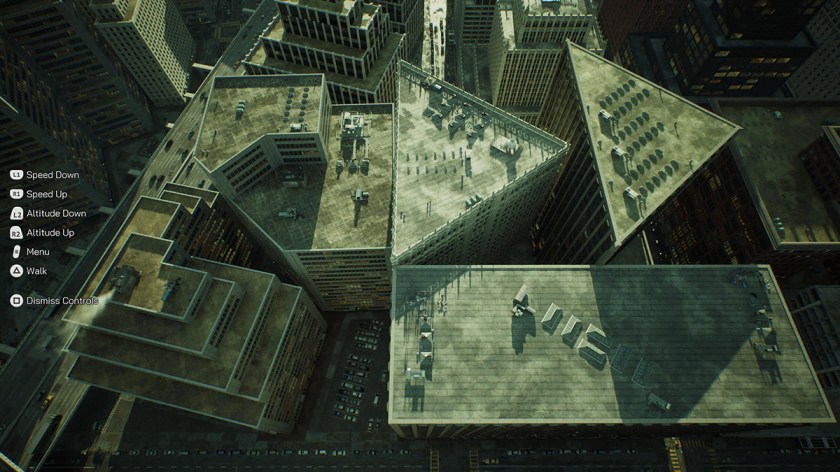
13 Sentinels Aegis Rim
This is the game I’m currently playing, and I knew very little about it going in. I knew it was made by Atlus, who I love, it was an RPG, which I love, and had cover art in a visual style that, yes, I love. As it turns out, the whole game is in that 2D water color-esque style, and it’s so lovely. The characters are 2D and the narrative environments are kind of 2.5D in that they are mostly 2D but you can walk a little to the front and back of the space. The characters look hand sketched/painted, and their avatars, while made up of 2D static art, are also animated, making them look like paintings come to life. So far, the thing I like most about the game is just appreciating every new environment and character I come across. I really love the game’s art style so far.


The story, up to the point that I’ve played (I’m about 6 hours in and nearing the end of the “tutorial” segment) seems to be a cross between Neon Genesis Evangelion (high schoolers piloting giant mechs to defend Japan from kaiju) and Terminator (time travel as a means to avoid future catastrophe), but there is more at play, I’m sure. In the short time I’ve played there have been a ton of fun cultural references, too, like E.T., The X-Files, Men in Black, Godzilla, and more. I was also so happy to hear familiar voice actors from the Persona games (Xanthe Huynh, Cassandra Lee Morris, Laura Post). The combat is grid-based strategy, which is usually hit-or-miss for me. So far, the battles have been very easy, so as long as they remain intuitive and not too frustrating, I’ll be good. I’ve really liked what I’ve played so far, so hopefully I’ll have time to write about it more when I finish it.


And that wraps up 2021 for me. 2022 is set to be a huge year for gaming, if the release schedule holds firm. Starfield, The Legend of Zelda: Breath of the Wild 2, Horizon Forbidden West, Elden Ring, God of War Ragnarok, Saints Row, PS VR 2, and more? I’m going to have to find time to write more regularly.

